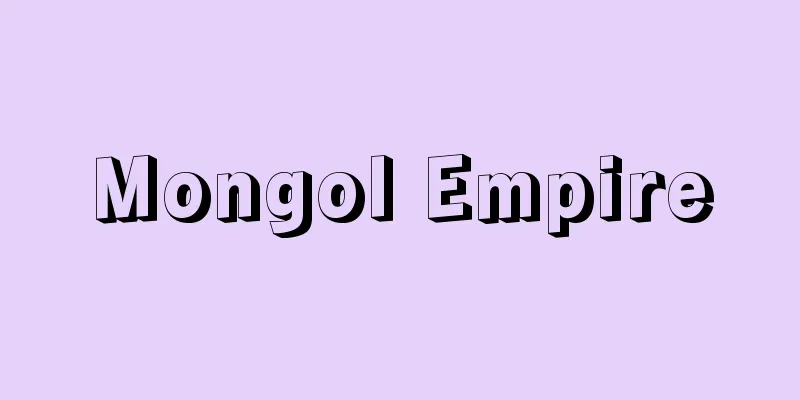Mongol Empire

|
An empire ruled by the Mongolians, founded by Genghis Khan in 1206. It was once referred to as the "Mongol Empire," but this term fell out of use because "Mongol" was deemed derogatory. [Masao Mamoru] Establishment of the EmpireIn the mid-12th century, many Mongolian and Turkish clans and tribes were scattered across the Mongolian Plateau, but Temujin, who was from one of the Mongolian clans, unified the Mongolian clans around 1189, was promoted to their leader, and was given the title of Genghis Khan. He then subjugated the neighboring Tatar, Merkit, and Kerait tribes, and destroyed the Turkic Naiman tribe based in the Altai region to the west, unifying the Mongolian Plateau. Genghis Khan became the Great Khan of all of Mongolia in 1206, and reformed the state structure based on the traditional clan and tribe system, dividing the country's nomadic people into 95 groups of 1,000 households. The 1,000 households and the 100-household groups that made up them were administrative and military units, with the 1,000 households required to provide approximately 1,000 soldiers and the 100 households required to provide approximately 100 soldiers. Meritorious retainers were appointed as the Chief of 1,000 Households and Chief of 100 Households, and these were placed under the command of the Chief of 10,000 Households on the left wing (the direction of the Khingan Mountains), the center army, and the right wing (the direction of the Altai). The children of the Chief of 10,000 Households, Chief of 100 Households, and Chief of 100 Households formed the Great Khan's personal guards, called Keshiktei, and swore allegiance to Genghis Khan's family and were given various privileges. Genghis Khan invaded the agricultural regions of the south, such as Jin and Western Xia, to strengthen the financial foundation of his state, plundering many horses, camels, and wealth, and taking prisoner artisans and farmers, moving them to the interior of the nomadic areas and establishing many settlements. He also advanced his army westward to secure the East-West trade route to the Eurasian continent. First, he defeated Prince Kuchluk, chief of the Naiman tribe, who had fled to Western Liao (Kara-Khitai) and become its king, and annexed the area. Next, he sent a trade mission to the Khwarezmian Shah Dynasty, which considered itself the protector of the Islamic world in Western Asia, and when the mission was massacred, he launched a great expedition westward (1219-25). Khwarezmian King Muhammad fled to an isolated island in the Caspian Sea and died there, and his prince Jeral-ud-din was defeated in a decisive battle on the banks of the Indus River and fled to India. The Mongol army went further, defeated the combined forces of the Russian princes, plundered the Crimean Peninsula, and returned home. Genghis Khan soon attacked Western Xia, where he died of an illness (1227). After Genghis Khan returned in triumph from his western expedition, he gave the nomadic areas of his territory, along with the nomadic peoples, to his sons and younger brothers. He decided to hand over the Mongolian mainland to his youngest son, Tolui, and to give the former land of the Naiman tribes, centered around the Ili River basin, and the northwest Mongolian plateau to his third son, Ogedai (Ogedai Khanate), and the former land of the Western Liao Dynasty, and Central Asia to his second son, Chagatai (Chagatai Khanate). He decided that the Kipchak steppe in southern Russia would become the territory of his eldest son, Jochi (later to become the Kipchak Khanate). He also gave fiefs to his younger brothers in the eastern Mongolian plateau and Manchuria (roughly what is now northeast China), and made the agricultural areas in the south the shared property of the clan, and stationed Dargachi (deputies) and garrisons there to maintain order and collect taxes. [Masao Mamoru] Territorial expansionPreviously, the khan was chosen by the Kurultai, a meeting of powerful tribal chiefs, but after Genghis Khan ascended to the throne, this custom became mere formality, and when he died, the Kurultai appointed Ogedei, whom he had nominated, as the Great Khan. Ogedei resumed a large-scale war against the Jin, defeated them, and occupied China north of the Huai River (1234). To the west, he ordered Jochi's second son Batu to attack Russia and various parts of Europe (1236-42). As a result, southern Russia became the territory of the Mongol Empire, and the Golden Horde was established there. Ogedei Khan built his capital, Karakorum Castle, in the upper reaches of the Orkhon River, opened roads to various parts of his territory from here, and established a relay system along the roads. The relay system was a system in which stations were set up at intervals of a day's distance by horse, and the stations were made to provide food, horses, cars, etc., for the convenience of the movement of envoys, government officials, and military forces, as well as the transportation of tributes and other items. This facilitated transportation within the vast territory and promoted exchanges between Eastern and Western civilizations. Ogedei also used scholars and cultural figures from the conquered territories, such as Yelu Chucai, to improve the administrative system and implement the first fixed tax law. After Ogedei Khan's death, his empress became regent, and then Ogedei's eldest son Güyük became the third Great Khan, but when he died, the empress became regent. This period of vacancy in the position of Great Khan continued due to conflict between Ogedei's family and the Tului family, which sided with Batu. The Ogedei family supported Ogedei's grandson Shilemun as the next Great Khan, while Batu supported Tului's eldest son Mongke, and they fought each other, but in the end Mongke became the fourth Great Khan, and from then on the position of Great Khan in the Mongol Empire and the Yuan Dynasty was monopolized by the descendants of Tului. These conflicts and strife within the family were an important cause that eventually led to the division of the Mongol Empire. In the ten years since Ogedei's death, Mongke Khan overhauled the chaotic governing system, reformed the government system, secured key locations in northern China and Turkestan, conducted household surveys and revised the tax system. After Mongke Khan was successful in reunifying the country, he sent his second brother Kublai Khan to invade Sichuan, Yunnan, Annam and Tibet, and his third brother Hulagu to pacify Islamic countries. Hulagu invaded Iran, captured Baghdad, destroyed the Abbasid Caliphate (1258) and established the Ilkhanate in Iran. Mongke Khan also participated in the campaign to invade the Southern Song Dynasty, but died of an illness in Sichuan Province on the way. [Masao Mamoru] The Disintegration of the EmpireAfter Mongke Khan died, his youngest brother Arik Buha, who was in charge of the capital Karakorum, tried to become the Great Khan with the support of his subordinates and the kings of the Ogedei line. Kublai Khan therefore made a temporary peace with the Southern Song Dynasty and returned to the Inner Mongolian Plateau, where he became the fifth Great Khan with the support of his confidant, the Kurultai, and suppressed Arik Buha. In 1271, he named the country Yuan. Those who were dissatisfied with this chose Ogedei's grandson Haidu as Khan and opposed Kublai Khan, starting a 30-year civil war. The Kipchak and Chagatai Khanates sided with Haidu, while the Ilkhanate sided with Kublai Khan, and Kublai Khan's side ended up winning (1303), but by that time both Kublai Khan and Haidu had already died. This battle was between the Yuan dynasty and the Ilkhanate, which had become more civilized by dominating both nomadic and agricultural lands, and the other khanates that sought to maintain their traditional nomadic traditions by using the nomadic lands as their base. As a result, the Mongol Empire was effectively divided, but as the other khanates that had been in conflict with the Yuan dynasty gradually became more civilized, they made peace with the Yuan dynasty, and the solidarity of the Mongol Empire was restored. Thus, the Yuan dynasty was regarded as the legitimate suzerain of the Mongol Empire, and the three other khanates, the Kipchak, Chagatai, and Ilkhanates (except for the Ogedai Khanate, which had already been destroyed in 1310), allied with it. The Eurasian continent enjoyed the so-called "Pax Tatarica" (Tatar Peace), and cultural exchange between Asia and Europe became even more active. However, the Mongol Empire lost the unity that had been maintained by the power and blood ties of the Great Khan of the Mongolian Plateau until the reign of Mongke Khan, and became nothing more than a confederation of kingdoms consisting of the Yuan Dynasty as the suzerain state and the three independent khanates outside of that government. This confederation also collapsed with the fall of the Yuan Dynasty (1368). [Masao Mamoru] "Oriental History 7: The Great Mongol Empire" by Tamura Jitsuzo et al. (1967, Jinbutsu Oraisha) " "Iwanami Lectures on World History 9: Middle Ages 3" by Mori Masao et al. (1970, Iwanami Shoten) " "Dawson, translated and annotated by Saguchi Toru, History of the Mongol Empire, six volumes (Heibonsha, Toyo Bunko)" [References] | | | | |©Shogakukan "> Mongol Empire / Brief family tree ©Shogakukan "> The development of the Mongol Empire Source: Shogakukan Encyclopedia Nipponica About Encyclopedia Nipponica Information | Legend |
|
1206年チンギス・ハンが創建したモンゴル民族支配の帝国。かつては「蒙古(もうこ)帝国」と表記されることもあったが、「蒙古」に蔑称の意味が含まれることなどから使用されなくなった。 [護 雅夫] 帝国の成立12世紀の中ごろモンゴル高原の各地には多くのモンゴル系、トルコ系の氏族・部族が割拠していたが、モンゴル民族の一氏族出身のテムジンは1189年ごろモンゴル諸氏族を統一してその盟主に推され、チンギス・ハンの称号を贈られた。彼は、ついで近隣のタタール、メルキット、ケレイト諸部族を服属させ、西方のアルタイ方面に拠(よ)ったトルコ系のナイマン部族を滅ぼしてモンゴル高原を統一した。チンギス・ハンは1206年モンゴル全土の大ハンの位につき、従来の氏族・部族制度に基づく国家機構を改めて、国内の遊牧民衆を95個の千戸集団に分けた。千戸およびそれを構成する百戸集団は行政単位であるとともに軍事単位で、千戸は約1000人、百戸は約100人の兵士を提供することに定められていた。千戸長、百戸長には功臣を任命して、これらを左翼(興安嶺(こうあんれい)方面)、中軍、右翼(アルタイ方面)の万戸長の指揮下に置いた。万戸長、千戸長、百戸長の子弟はケシクテイとよばれる大ハンの親衛隊を構成して、チンギス・ハン一族に忠誠を誓うとともに各種の特権を与えられた。 チンギス・ハンは、国家の財政的基礎を固めるため、金、西夏など南方の農耕地域に侵入し、多数のウマ、ラクダ、財物を略奪し、職人、農民を捕虜にして遊牧地帯内部に移住させ多くの集落をつくった。またユーラシア大陸に通ずる東西貿易路を確保する目的で西方へ軍を進めた。まず、ナイマン部族の族長の王子クチュルクが西遼(せいりょう)(カラ・キタイ)へ亡命して王となっていたので、これを討ってその地を併合した。ついで、西アジアのイスラム世界の保護者をもって自任していた、ホラズム(フワーリズム)・シャー朝に通商使節団を派遣して、これが虐殺されたのを機に西方への大遠征を敢行した(1219~25)。ホラズム国王ムハンマドはカスピ海中の孤島に逃れて死に、その王子ジェラール・ウッディーンはインダス河畔の決戦で敗れてインドに逃亡したという。モンゴル軍はさらに進んでロシア諸公の連合軍を撃破し、クリミア半島を略奪して帰国した。チンギス・ハンはまもなく西夏を討ち、その際病死した(1227)。 チンギス・ハンは、西方遠征から凱旋(がいせん)したのち、その領土のうち、遊牧地域は、そこに遊牧する民衆とともにこれを諸子、諸弟に与えた。モンゴル本土は、これを自分の領土として末子のトゥルイに譲ることに決め、イリ川流域を中心とするナイマン部族の故地、北西モンゴル高原を第3子オゴタイ(オゴタイ・ハン国)に、西遼の故地、中央アジアを第2子チャガタイ(チャガタイ・ハン国)にそれぞれ分与し、南ロシアのキプチャク草原は、将来これを長子のジュチの領土とすることにした(のちにキプチャク・ハン国となる)。また、東部モンゴル高原、満州(ほぼ今日の中国東北)方面には弟たちを分封し、南方の農耕地帯は、これを一族の共有財産とし、そこにダルガチ(代官)、駐屯軍を配して治安維持、徴税にあたらせた。 [護 雅夫] 領土の拡大ハンは、以前には有力な部族長たちの会議であるクリルタイで選ばれることになっていたが、チンギス・ハンの即位後はこの慣習は形式だけのものとなり、彼が死ぬと、クリルタイは彼の指名しておいたオゴタイを大ハン位につけた。オゴタイは金に対して大規模な戦争を再開し、これを滅ぼして淮河(わいが)以北の中国を占領し(1234)、西方に向かっては、ジュチの第2子バトゥに命じてロシア、ヨーロッパ各地を討たせ(1236~42)、この結果、南ロシアがモンゴル帝国の領土となり、ここにキプチャク・ハン国が成立した。オゴタイ・ハンは、オルホン川の上流域に首都カラコルム城を築き、ここを起点として領内各地への道路を開いて、その沿道に駅伝の制度を整えた。駅伝は、普通にはウマで1日行程ほどの距離ごとに駅舎を設け、その站戸(たんこ)に食糧、ウマ、車などを提供させて、使節・官吏・軍隊の往来、貢納そのほかの運搬の便を図ったもので、これによって広大な領土内の交通が容易になり、東西文明の交流が促進された。また、オゴタイは耶律楚材(やりつそざい)ら征服地帯の学者、文化人を用いて行政機構を整備し、最初の定額税法を施行した。 オゴタイ・ハンの死後、彼の皇后が摂政したのち、オゴタイの長子グユクが第3代の大ハン位についたが、彼が死ぬとその皇后が摂政となった。このように大ハン位の空白時代が続いたのは、オゴタイ一門とバトゥの味方するトゥルイ一門とが対立したためである。オゴタイ一門は次代の大ハンとしてオゴタイの孫シレムンを、これに対してバトゥはトゥルイの長子モンケを推して互いに争ったが、結局モンケが第4代の大ハンとなり、これ以後、モンゴル帝国~元(げん)朝の大ハン位はトゥルイの子孫によって独占されることになった。そして、こうした一族内部での対立抗争が、やがてモンゴル帝国を分裂に導く重要な原因となった。 モンケ・ハンは、オゴタイの死後約10年の間に乱れた統治機構を刷新し、官制を改革するとともに、華北、トルキスタンの要地を確保し、戸口調査を実施して税制を改正した。モンケ・ハンは内部の再統一にいちおう成功すると、次弟フビライを四川(しせん)、雲南、安南、チベットの討伐に出軍させ、第3弟フラグをイスラム教国の平定に派遣した。フラグはイランに侵入して、バグダードを攻略し、アッバース朝を滅ぼし(1258)、イランにイル・ハン国を建てた。モンケ・ハンも南宋(なんそう)討伐作戦に加わったが、その途中四川省で病死した。 [護 雅夫] 帝国の分裂モンケ・ハンが死ぬと、首都カラコルムでその留守を預かっていた末弟のアリク・ブハは、部下およびオゴタイ系諸王の支持を得て大ハン位につこうとした。そこでフビライは南宋(なんそう)と一時的に和平を結んで内モンゴル高原に帰り、腹心だけのクリルタイの推戴(すいたい)を受けて第5代の大ハンとなり、アリク・ブハを鎮圧して、1271年に国号を元(げん)と定めた。これに不満をもつ者は、オゴタイの孫ハイドゥをハンにいただいてフビライと対立し、ここに30年にわたる内戦が開始された。キプチャク、チャガタイ両ハン国はハイドゥ側にたち、イル・ハン国はフビライ側に味方して戦い、結局フビライ側の勝利に終わったが(1303)、そのときは、すでにフビライもハイドゥも死んだあとであった。この戦いは、遊牧・農耕両地帯を領有することによって開化した元朝、イル・ハン国と、遊牧地帯を本拠として従来の遊牧的伝統を保持しようとする諸ハン国との間の抗争であった。この結果、モンゴル帝国は事実上分裂したが、そののち、元朝と対立した諸ハン国がしだいに開化するに及んで、それらは元朝と和議を結ぶようになり、モンゴル帝国の連帯性が復活した。こうして、元朝はモンゴル帝国の正統を継ぐ宗主国とみなされ、すでに1310年に滅亡していたオゴタイ・ハン国を除く他のキプチャク、チャガタイ、イルの三ハン国はこれと連合し、ユーラシア大陸は、いわゆる「パクス・タタリカ」(タタールの平和)を享受し、アジアとヨーロッパとの間の文化交流は一段と活発になった。しかし、モンゴル帝国は、モンケ・ハンの治世までモンゴル高原の大ハンの権力と血縁のつながりとによって保っていた統一性を失い、元朝を宗主国とし、これとその政権外に独立した三ハン国とによって構成された連合王国にすぎなくなった。そして、この連合王国も元朝の滅亡(1368)によって崩壊した。 [護 雅夫] 『田村実造他著『東洋の歴史7 大モンゴル帝国』(1967・人物往来社)』▽『護雅夫他著『岩波講座 世界歴史9 中世3』(1970・岩波書店)』▽『ドーソン著、佐口透訳注『モンゴル帝国史』全六巻(平凡社・東洋文庫)』 [参照項目] | | | | |©Shogakukan"> モンゴル帝国/略系図 ©Shogakukan"> モンゴル帝国の発展 出典 小学館 日本大百科全書(ニッポニカ)日本大百科全書(ニッポニカ)について 情報 | 凡例 |
<<: Montgolfier Brothers - Frères Montgolfier
>>: Mongol people - Mongol (English spelling)
Recommend
Surin
An Indonesian vertical flute with a ring at the mo...
Kritias
Around 460 before - 403 before Athenian politician...
Witherspoon, J.
…[Imai Hiroshi] Today, the most influential churc...
Ionia (English spelling)
The ancient Greek name for the central west coast ...
Antrim Tablelands
…(7) Southwest England Highlands The plateau is m...
British Artists Association
...After that, the Salon de la Société des artist...
Grey thrush
A bird of the Turdus subfamily, family Muscicapid...
Pleissenland
...The Wettin family first established a strong b...
Civilization - Kaiminka
...But it also gave birth to a new intellect that...
Ganjam - Ganjam
...But it was later invaded by the Chola dynasty,...
Tsubo-tsuke - Tsubo-tsuke
It is also called "Tsubozuke." It refer...
Echeveria setosa - Echeveria setosa
...The leaves are often bluish-white in color, bu...
Djerma
… [Nobuyuki Hashimoto] [Residents, Society] The m...
Enagarasu - Enagarasu
…He first studied in Vienna, then organic chemist...
Palm civet
A general term for a mammal of the order Carnivora...









